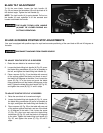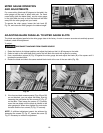
19
Fig. 38
1. NOTE: One 7/8" wrench is supplied with the saw for
changing the saw blade.
2. Remove table insert (A) Fig. 38, and raise saw blade
(F) to its maximum height.
3. To remove blade, place the wrench (D) on the flats of
the arbor nut (C) to keep the arbor from turning. Place a
piece of wood (B) flat on the table against the blade so
that a tooth of the blade can “grab” the wood to keep
the blade from turning. Use wrench to turn the arbor nut
toward the front of the saw. Remove arbor nut, blade
flange (E), and saw blade.
4. Assemble the new blade, making certain the teeth
point down at the front of the saw table, and assemble
outside blade flange and arbor nut. Using the piece of
wood (B) to keep the blade from turning, tighten arbor
nut by turning wrench (D) toward the rear of the saw.
5. Replace table insert.
F
C
E
D
B
A
CHANGING THE BLADE
DISCONNECT THE MACHINE FROM THE POWER SOURCE. USE ONLY 10" DIAMETER SAW BLADES
RATED FOR 4700 RPM OR HIGHER. USE ONLY SAW BLADES WITH 5/8" ARBOR HOLES.
CROSS-CUTTING
Cross-cutting requires the use of the miter gage to
position and guide the work. Place the work against the
miter gage and advance both the gage and work toward
the saw blade, as shown in Fig. 39. The miter gage may
be used in either table slot. When bevel cutting (blade
tilted), use the table groove that does not cause
interference of your hand or miter gage with the saw
blade guard.
Start the cut slowly and hold the work firmly against the
miter gage and the table.
ONE OF THE RULES IN RUNNING A
SAW IS THAT YOU NEVER HANG
ONTO OR TOUCH THE PART OF THE WORKPIECE
THAT WILL BE CUT OFF.
Hold the supported piece, not the free piece that is cut
off. The feed in cross-cutting continues until the work is
cut in two, and the miter gage and work are pulled back
to the starting point. Before pulling the work back, it is
good practice to give the work a little sideways shift to
move the work slightly away from the saw blade. Never
pick up any short length of free work from the table while
the saw is running. Never
touch a cut-off piece unless it
is at least a foot long.
Common sawing operations include ripping and crosscutting plus a few other standard operations of a fundamental
nature. As with all power machines, there is a certain amount of hazard involved with the operation and use of the
machine. Using the machine with the respect and caution demanded as far as safety precautions are concerned, will
considerably lessen the possibility of personal injury. However, if normal safety precautions are overlooked or completely
ignored, personal injury to the operator can result. The following information describes the safe and proper method for
performing the most common sawing operations.
THE USE OF ATTACHMENTS AND ACCESSORIES NOT RECOMMENDED BY DELTA MAY RESULT
IN THE RISK OF INJURY TO THE USER OR OTHERS.
Fig. 39
MACHINE USE
For added safety and convenience the miter gage (A)
can be fitted with an auxiliary wood-facing (B), as shown
in Fig. 39A, that should be at least 1 inch higher than the
maximum depth of cut, and should extend out 12 inches
or more to one side or the other depending on which
miter gage slot is being used. This auxiliary wood-facing


















